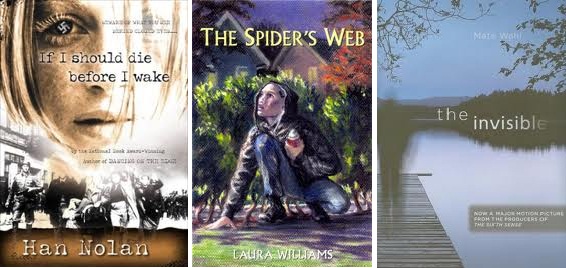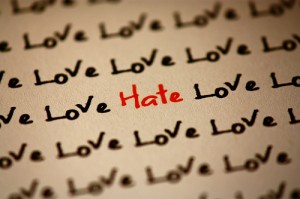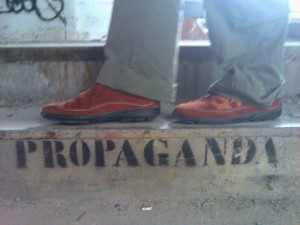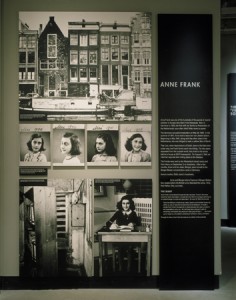What is hate, and how do we combat it? Recently, I attended a symposium organized by Gonzaga University’s Institute for Hate Studies and American University’s Washington College of Law. The symposium was on “Hate and Political Discourse” and was organized by John Shuford and Robert Tsai in honor of the Journal of Hate Studies 10th Anniversary issue that is forthcoming this October. Additionally, I visited the United States Holocaust Memorial Museum for the first time and want to use this blog to reflect on those experiences and offer some suggestions for the importance of the humanities in combating hate.
The Hate Studies Symposium was a fairly intimate event. The group of scholars chosen for the event was an interdisciplinary one, although it was weighted towards work on the law and legal issues related to hate, including the keynote speaker Professor Mari Matsuda. The questions we set out to consider were “what do we mean by hate in political discourse?” the definitional problem or challenge and “where does hate come from/how is it sustained?” which leads us to ask “what are the solutions?”
Matsuda’s keynote “Is Peacemaking Un-American? On Violence and Ideology” directly addresses some of the concerns that I try to evaluate in my book manuscript and my teaching. She argued that to say “there’s no such thing as a false idea” is problematic for a variety of reasons. The notion that all ideas are equally true, based on locating them in the realm of opinion is something commonly seen in American culture, including things as forgettable as this commercial for Elmer’s Glue:
“But that’s just my depinion” the little girl says, and the assumption is that this is something cute, it’s adorable how she uses that adult phrase to refer to glue. But this is a larger claim than just a preference for adhesives, and one that continually causes problems to those who attempt to combat hate speech. If every opinion is equally true, then no opinions can be challenged. It follows from that how no opinions can then be changed. This is what Kwame Anthony Appiah refers to when he criticizes relativism in his book Cosmopolitanism: Ethics in a World of Strangers. The notion of relativism deployed by “that’s just my opinion” shuts down discourse, limits interaction, and sustains false ideas. Matsuda also reminded participants of one of the fundamental arguments behind my research and my spring “Cosmopolitan Imagination” course: literature can humanize the “over there.” I look forward to exploring this for a second time with texts like In the Time of the Butterflies, Persepolis, and Interpreter of Maladies.
Other presenters from Faculty Workshop I asked us to consider Willa Michner’s “The Psychology of Group Hate”–how groups are associated with the negative that any group member has done, such as responses to American Japanese post-Pearl Harbor and perceived Muslims post-9/11. This creates what Michner refers to as “algorithms of fear” on a psychological level. Examples of this type of group hate were covered in Marla Stone’s talk on Italian Fascism and propaganda, how propaganda was used in pre-WWII Italy to associate all Soviets with a clearly racially defined “other” that functioned as a threat to the Italian state. Finally there was Damon Berry’s discussion of abjection and blood libel- a compelling paper for my theory-loving heart. Berry argued that abjection is one important way to understand the pervasive history of the concept of blood libel–the dislike of the crossing of boundaries and the narrative of contamination that is prevalent in blood libel stories from ancient Rome, medieval Poland, and contemporary Palestine and England.
In Faculty Workshop II there were presentations on constitutional histories of lynching from Daniel Kato, legal definitions of hate crimes from Jennifer Scheweppe, and my talk on neo-Nazis in young adult (YA) literature. While these three topics might seem quite disparate, Dr. Robert Tsai (conference organizer) pointed out how the common thread was in considering competence and hate crimes. What does this competence require on behalf of citizens? Who is competent to challenge hate crimes? I would argue that this question of competence could go by another name: empowerment. How can we empower individuals to make good decisions when encountering hate? What sort of empowerment might it take to encourage the idea that we can be wrong, and that’s okay? My argument is that literature is one place where we can do this. Humanizing the “over there” is one possible avenue for the humanities and combating hate. Literature can, however, also point us to ways to discuss what Appiah calls “values not worth living by.”

Books from my talk on neo-Nazis and YA Lit:
If I Should Die Before I Wake, The Spider’s Web, and The Invisible.
My argument is that young adult literature that features neo-Nazi characters can help readers look at how some ideas are false, some values not worth living by, in how they ask readers to consider the misery and violence that the neo-Nazis inflict on themselves and their communities. However, in these books its essential that responses come from two places: individual realization on the part of characters and community responses when faced with hate speech. One of the challenges that I see for humanities work on hate studies is in how we can ask readers to critically evaluate that “over there” through literature and come away with an empowerment to discuss, to engage, and to promote change. This constantly butts up against the desire of people to respond to the “over there” by embracing their own privilege, rather than interrogating their position within power structures that ask us to accept “well that’s just my opinion” as acceptable public discourse.
This question of privilege is one that the United States Holocaust Memorial Museum skirts, but does not directly address, yet I don’t actually know if this particular Museum should be dedicated to interrogating privilege. (Hello, Museum of Slavery, where are you?) This is a conversation that I’m still considering, so please leave comments! Certainly, it asks us to think through why ideas can be false, why values can be wrong, and the extreme example of what happens when false ideas become institutionalized facts about a minority group. Then it asks us to transform that knowledge into testimony, to become witnesses when we were once spectators. I’ve spent, at this point, years of my life studying the Holocaust and its representations. With all of that knowledge I was surprised at how much the Museum affected me. I don’t know what I expected from the experience, and I’m still having a hard time articulating how my expectations and the reality aligned. I was overwhelmed and drained, there’s not doubt about that.
I’ve considered the performative aspects of the Museum before and so was aware of some of the logic behind the space and exhibit planning. In Vivian Pataka’s book on theater and the Holocaust she has a excellent chapter (“Spectacular Suffering”) covering the USHMM, which I recommend for anyone doing critical work on the Holocaust and memory. As a small sample:
The use of artifacts and dense documentation to produce knowledge and historical presence, and to shape memory, also convey the incommeasurability of the loss by making this density manageable for the viewer. What is critical about the D.C. museum, then, is in its use of small bits of everything–shoes, documents, photographs, artifacts–is the sheer, unbearable magnitude of detail (127).
Yet even knowing that, stepping into the elevator holding my ID card (I was a Polish Catholic resistor who survived–several elements that echo my family history accurately) and emerging into the scenes of the liberation of the camps immediately struck me as much more emotionally impacting than I had anticipated. The Museum is dim, laid out to promote reflection, and an example of how architecture can really enhance the experience of the content. It is both a Memorial and a Museum, and not just because it contains the eternal flame and hall of witness. The way the designers used light and space, in addition to content and artwork, was a reminder of how important architecture is. The use of light in the rooms full of pictures from Eisiskes, the path that encourages you to walk through one of the train cars, and the smell of the room of shoes are all the non-verbal performative elements that make it an often-times overwhelming experience.

The room of shoes, the interior of a deportation train, the images of Eisiskes.
All images courtesy of the USHMM.
I recoiled at the smell of those shoes. I didn’t want to walk through that train car. I cried (a LOT) when looking at the living faces of the residents of Eisiskes.
As I wound my way through the exhibits a few things struck me that seem worth noting. First, it is detailed and accurate and tries its best to remind visitors of the role America played in the Holocaust–and not always as saviors. While that’s the first image you get upon exiting the elevator on the third floor, there are comments throughout on the way antisemitism functioned in America and how that limited immigration and ultimately left European Jews to their fate. I’ve heard complaints, which seem fair, about the small amount of emphasis placed on disabled, homosexual, and Roma-Sinti populations that were also targeted for elimination by the Nazis. There were information on these groups, which was important, but it definitely is a side-note to the main focus. In particular I wish the Museum would have reminded viewers how the overall population of Roma-Sinti in Europe was decimated to an even greater extent (percentage-wise) than the Jewish population. Or how the disabled were the test subjects for what would eventually become the gas chamber-based Final Solution.
I was also surprised at how continually I was reminded of the fiction that I’ve been writing about. The descriptions of the ghettos were overlaid with my experiences from The Cage, Milkweed, If I Should Die Before I Wake, and others. You can’t walk through the train car without recalling Night. Looking at Anne Frank’s face as she smiles at us from pre-invasion Amsterdam is another moment of heartbreaking happiness that we are forced to counter with our historical knowledge. Even the einsatzgruppen are featured in young adult literature, making an appearance in A Family Secret. At every turn I was confronted with memories, fictional memories of the events displayed throughout the Museum. This is why young adult Holocaust fiction is such an important thing to consider: it is where our memories of the Holocaust are built, particularly as the years pass and direct connections such as survivors pass away. I found myself repeatedly wanting to grab the people next to me and offer extra information, “No! You don’t understand how awful it was! That man in the film footage of the ghetto without shoes? He most likely sold them for food. Eventually he will sell all of his warm things in an attempt to stave off starvation. Then he will freeze to death, having given away everything in a bid to survive just one more day.” (You see this in Milkweed as the young protagonist begins to realize what the lumps covered with newspaper in the street actually are: bodies. Children’s bodies take only one sheet to cover.) Naturally, I did NOT grab random strangers and press unwanted information on them. But it seems like necessary information as well. While the Holocaust Museum gives us the facts, it doesn’t give us the experience of those “over there.” For that we need fiction, we need the presence of our imaginations to inhabit experiences other than our own.






Thank you for this wonderful summary of the event and the discussions.
Hey, Damon, do you have a link to the Daily Show clip you referenced in your talk? That might add another dimension to my overview of your blood libel paper.
Here it is from the show. http://www.thedailyshow.com/watch/tue-february-2-2010/story-hole—children-s-cartoons-from-hamas